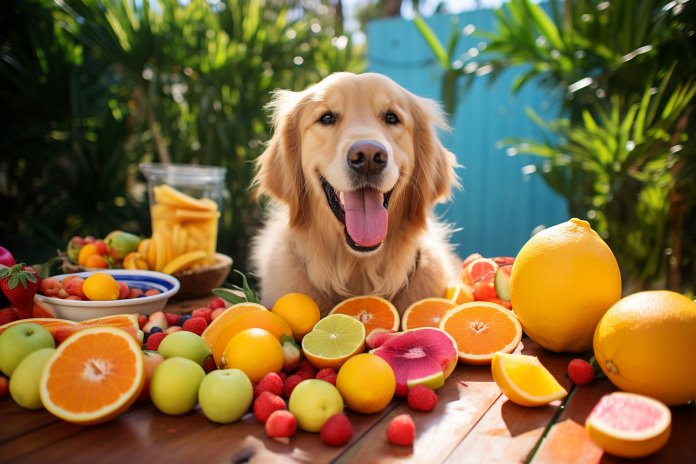
Sometimes simple questions are the most intriguing, like “What makes food tangy?” It’s actually harder than you think to pinpoint what exactly makes food tangy or how to describe it. If our taste buds could talk, they might describe tangy as similar to sour, but with a little more zest. But what does ‘zest’ really mean?
We tend to recognize the lipsmacking taste of tangy when we experience it.
It often appears in foods where opposites attract, like sweet ‘n’ sour or a savory dish with a hint of lemony acidity.
But if we struggle to define what tangy is, where does that leave our four-legged friends?
Can dogs even distinguish between tangy and other flavors like sweet, sour, or bitter?
Signs of Dogs Tasting Tangy Food
Just like people, dogs have individual tastes. What may be pleasant for one person could be unpleasant for another. Dogs are no different. Some dogs will eat anything that fits in their mouth without tasting it, while others are more picky and won’t be tempted even by the tastiest morsels.
However, for the average dog, the first response to tangy food is based on smell. Dogs have a highly developed sense of smell, so they will approach the food and sniff it to determine if it’s safe to eat. They have different sniffing patterns depending on their distance from the food. Closer to the food, they take fewer but deeper breaths to fully explore its aroma and freshness.
If the dog encounters a tangy food they’re unsure about, they will likely lick it tentatively and then lick their lips to decide if they want to eat it. Once they’ve made a decision, most dogs will chew and gulp the food rather than savoring its flavor.
Body Language
Signs that a dog is reacting to tangy food include being alert, tilting their head, chewing, wagging their tail, sniffing, and raising their ears. Other signs to watch out for include gulping down food, lip smacking, guarding the food bowl, and circling around it.
A History of the Canine Sense of Taste
Thousands of years ago, the ancestors of modern dogs relied on their sense of smell to scavenge and hunt for food. The ability to taste was useful in determining if food was rancid or decaying, as these often have bitter or sour flavors. Over time, dogs learned to prefer certain tastes that indicated the food was nutritious.
The Science of a Dog’s Sense of Taste
Dogs have taste buds just like humans, but they have far fewer. While humans have around 9,000 taste buds, dogs only have about 1,700. This is because the dog’s brain prioritizes their highly developed sense of smell and hearing, leaving less processing power for taste.
However, dogs have an additional taste receptor for water, which humans lack. These receptors are found on the tip of the tongue and help dogs avoid drinking salty water.
Training a Dog to Taste Tangy Foods
A dog’s sense of taste is strongly influenced by their sense of smell. They often use both senses together to determine if they should eat a food. To train a dog to taste and detect tangy foods, you can play a game of tug with a clean towel and gradually introduce the tangy food on the towel. By associating the tangy taste with a positive experience, the dog can learn to recognize tangy flavors.
“Unlocking the Canine Palate: Exploring How Dogs Taste Tangy Foods”

Tips & Things to Know
1️⃣ Dogs can distinguish between different flavors, including tangy, but they rely heavily on their sense of smell to make this distinction. They will approach tangy food based on the smell and may lick it tentatively to determine if they want to eat it or not.
2️⃣ Dogs exhibit certain body language signs when reacting to tangy food, such as alertness, head tilting, chewing, wagging tail, sniffing, and raising ears. These signs indicate their interest and reaction to the flavor.
3️⃣ Training a dog to taste tangy foods can be done by incorporating their sense of smell. By associating the smell of tangy food with positive experiences, such as playing a game with a scented towel, dogs can learn to recognize and choose tangy foods.
Frequently Asked Questions, Answered ✅
1. Can dogs taste tangy food?
– Yes, dogs can taste tangy food, but their sense of taste is not as developed as humans. They can detect sweet, sour, bitter, and salty tastes, including tangy flavors.
2. How do dogs react to tangy food?
– Dogs may exhibit signs such as alertness, head tilting, chewing, wagging their tail, sniffing, and raising their ears when encountering tangy food.
3. How do dogs use their sense of smell to detect tangy food?
– Dogs have a highly developed sense of smell, and they use it to approach and investigate the smell of the food. They may sweep their head from side to side and take rapid, shallow breaths to locate the strongest scent.
4. What are some other signs that dogs may show when reacting to tangy food?
– Other signs to watch out for include gulping down food, lip smacking, guarding the food bowl, and circling around the food bowl.
5. How can dogs be trained to taste and detect tangy foods?
– Dogs rely heavily on their sense of smell to taste food, so training them to detect tangy flavors can be done by associating the smell of the tangy food with positive experiences, such as playing a game of tug with a scent-free towel and gradually introducing the tangy scent to the game.